In recent years, the concept of outdoor living spaces has gained tremendous popularity among homeowners seeking to create inviting environments where they can entertain, relax, and enjoy nature. One remarkable addition to these spaces is the outdoor kitchen, a haven for culinary enthusiasts and those who relish the joy of cooking amidst the beauty of the great outdoors.
Building an outdoor kitchen with wood offers a unique opportunity to blend functionality, aesthetics, and sustainability seamlessly. Wood, as a natural material, effortlessly enhances the overall ambience, creating a warm and inviting atmosphere that harmonizes with the surrounding environment. From selecting the right type of wood to understanding the best construction practices, we will guide you through the process, enabling you to transform your outdoor space into a captivating culinary oasis.
What We Have Covered
Wood Selection and Preparation

Choose wood species suitable for outdoor use
Selecting the appropriate wood species is vital for constructing a durable and long-lasting outdoor kitchen. Certain woods are better suited for outdoor use due to their resistance to rot, decay, and weather-related damage. Examples of suitable wood species include cedar, teak, redwood, and pressure-treated lumber. Factors such as availability, cost, and personal preferences should be considered when choosing the right wood for your project.
Considerations for durability, resistance to weather, and pests
Durability is of utmost importance when building an outdoor kitchen. The chosen wood species should have inherent qualities that make it resistant to weather conditions, such as rain, humidity, and UV radiation.
Proper wood treatment and sealing for longevity
To enhance the longevity of your outdoor kitchen and protect the wood from degradation, proper treatment and sealing are essential. Treating the wood with preservatives or stains can help protect it from moisture, fungi, and insect damage. Sealants, such as varnishes or water repellents, create a barrier that shields the wood from water penetration, UV rays, and other external factors.
Outdoor Kitchen Design and Layout
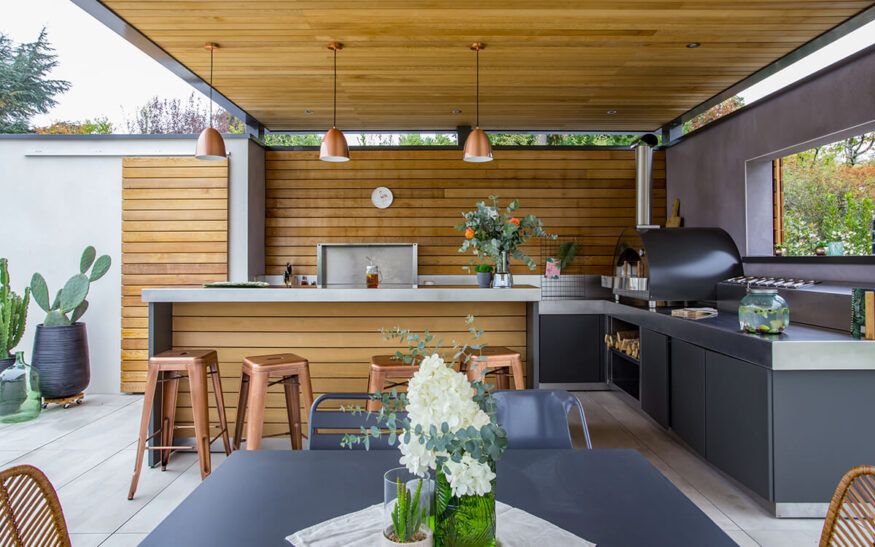
Assessing available space and functionality requirements
Before diving into the design and layout of your outdoor kitchen, it’s crucial to assess the available space and understand your specific functionality requirements. Evaluate the size and shape of the outdoor area where the kitchen will be located, considering factors such as existing structures, landscaping features, and access points.
Understanding your space limitations and functionality needs will help you optimize the design to create a practical and efficient outdoor kitchen.
Determining the layout and placement of key elements (grill, sink, countertop, etc.)
Once you have a clear understanding of the available space and functionality requirements, it’s time to determine the layout and placement. Consider essential components such as the grill, sink, countertop, and any additional appliances or features you desire, like a pizza oven or a bar area. Assessing the flow and organization of these elements is crucial to create a functional workspace that promotes ease of use and enhances your cooking experience.
Incorporating storage cabinets, drawers, and shelving
Consider the type and amount of storage you require, keeping in mind the outdoor environment. Opt for weather-resistant materials and consider waterproofing solutions to ensure the longevity and protection of your stored items. Here is a list of outdoor tv cabinets options you can use.
Construction Materials

- Pressure-treated wood is treated with preservatives that enhance its durability and resistance to rot, decay, and insect damage. Alternatively, you can opt for naturally rot-resistant wood species like cedar or redwood, which offer excellent longevity and structural integrity in outdoor environments.
- Siding and cladding options for aesthetics and protection
Siding and cladding contribute to both the aesthetics and protection of your outdoor kitchen. Various options, such as wood, stone veneer, stucco, or metal, can be used to enhance the visual appeal of your kitchen.
- Weatherproofing measures: Use waterproof membranes or moisture-resistant sheathing on the framework and walls to prevent water infiltration.
Key Components of an Outdoor Kitchen
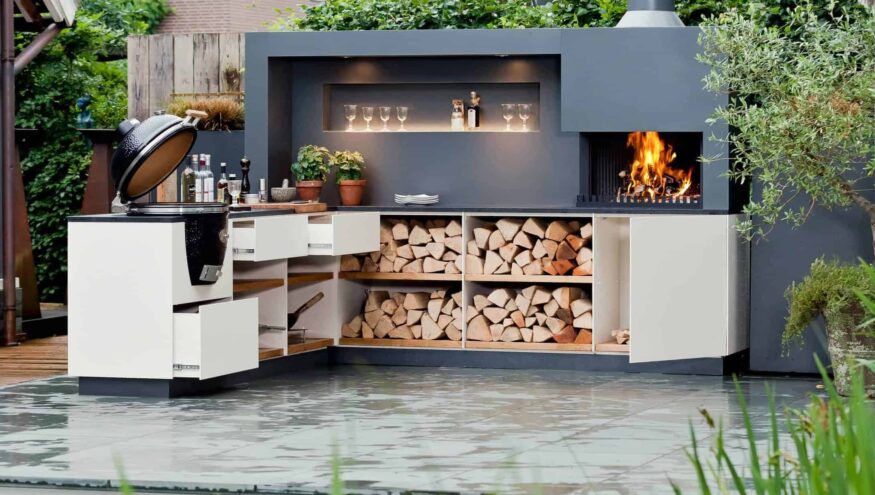
- Grill and Cooking Area
- Selection of suitable outdoor grills (gas, charcoal, wood-fired)
The selection of a suitable outdoor grill is a crucial aspect of creating an efficient and enjoyable cooking area in your outdoor kitchen. There are several options to consider, including gas, charcoal, and wood-fired grills. Each type offers its unique advantages and cooking experiences. Gas grills provide convenience, quick heat-up times, and precise temperature control.
- Proper ventilation and safety considerations
Ventilation is a crucial aspect of the grill and cooking area in your outdoor kitchen. Proper airflow and ventilation help dissipate smoke, odors, and heat, creating a comfortable and safe environment for cooking. C
Consider incorporating a range hood or overhead exhaust system to effectively capture and exhaust smoke and fumes. Additionally, ensure that the grill is positioned at a safe distance from flammable materials, structures, and overhead features to prevent fire hazards.
Countertops and Workspaces
- Materials suitable for outdoor use (granite, concrete, tile)
When it comes to selecting materials for countertops and workspaces in your outdoor kitchen, it’s essential to choose options that are suitable for outdoor use. Some popular choices include granite, concrete, and tile. Granite is a durable and visually appealing natural stone that offers excellent resistance to heat, scratches, and stains.
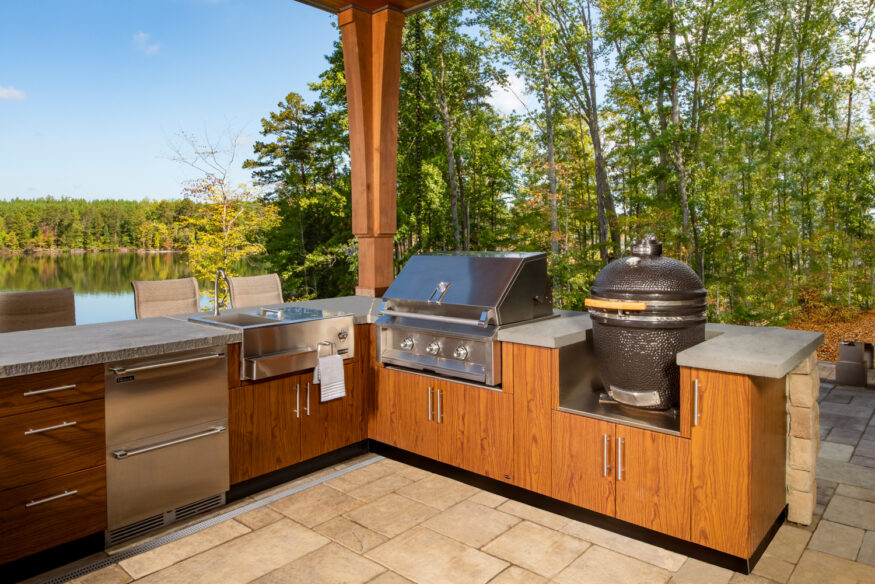
- Designing ample workspace for food preparation
An adequate workspace for food preparation is vital in an outdoor kitchen, as it ensures efficiency and convenience while cooking. When designing your countertops and workspaces, consider the activities you’ll be performing, such as chopping, slicing, and assembling ingredients. Aim for a sufficient amount of surface area to accommodate these tasks comfortably. Incorporate features like cutting boards or designated prep areas to maximize functionality.
Sink and Plumbing
- Installing a functional sink with a hot and cold water supply
Having a functional sink in your outdoor kitchen is essential for various tasks, such as food preparation, cleaning utensils, and washing hands. When installing a sink, ensure that it is designed for outdoor use and capable of withstanding the elements.
The sink should be equipped with both hot and cold water supply for added convenience and versatility. Hot water allows for easier cleaning and sanitizing, while cold water is useful for refreshing drinks or rinsing produce.
- Plumbing considerations and connecting to existing water lines
Proper plumbing is essential when incorporating a sink into your outdoor kitchen. Consider the location of existing water lines and the feasibility of connecting the outdoor sink to these lines.
Plumbing considerations may include the distance between the outdoor kitchen and the water source, access to plumbing connections, and potential obstacles or challenges. If connecting to existing water lines is not feasible, alternative options like installing a separate water supply system or using portable water reservoirs can be explored.
Outdoor Kitchen Appliances and Accessories
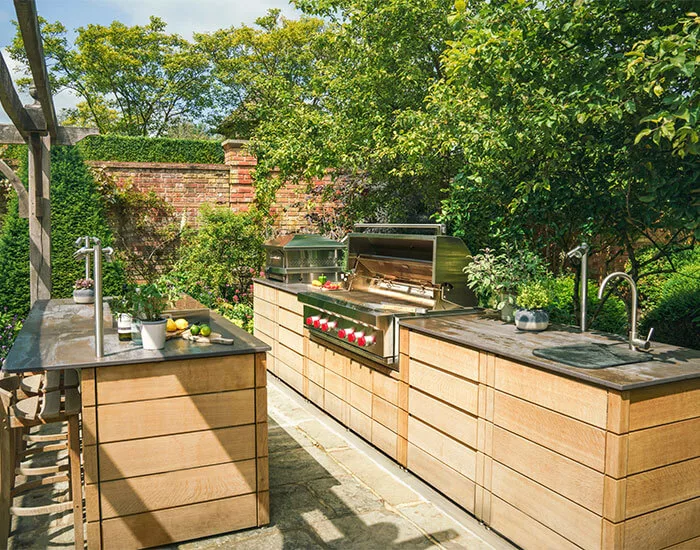
-
Refrigerators and ice makers
-
Outdoor-rated appliances (wine coolers, pizza ovens, smokers)
-
Lighting options for ambience and functionality
-
Outdoor kitchen accessories (utensil holders, cutting boards, spice racks)
Fire Safety and Ventilation

Placement of the outdoor kitchen in relation to flammable materials
The proper placement of your outdoor kitchen is crucial when it comes to fire safety. It is important to position your outdoor kitchen at a safe distance from flammable materials such as buildings, fences, overhanging structures, or vegetation.
Maintaining adequate clearance reduces the risk of fire spreading and minimizes the potential for accidental ignition. Follow local building codes and regulations regarding clearance requirements to ensure a safe and compliant outdoor kitchen setup.
Ventilation systems to dissipate smoke and prevent accumulation
Effective ventilation is essential in an outdoor kitchen to dissipate smoke, fumes, and heat generated during cooking. A well-designed ventilation system helps prevent the accumulation of smoke, ensuring a comfortable and safe cooking environment.
Fire extinguishers and safety precautions
Fire safety precautions are essential in any kitchen, including outdoor kitchens. Install a fire extinguisher in a readily accessible location near your outdoor kitchen. Ensure that it is suitable for extinguishing different types of fires, such as those caused by grease, wood, or electrical appliances.
Conclusion
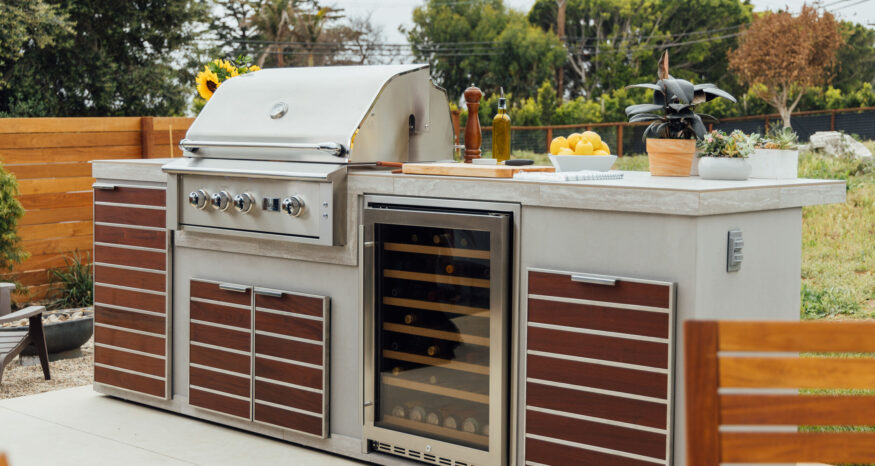
In conclusion, building an outdoor kitchen with wood offers a delightful and functional space for cooking and entertaining outdoors. By carefully selecting materials, considering safety measures, and adhering to local regulations, you can create a charming and durable outdoor kitchen that enhances your outdoor living experience.
So, let your creativity flourish and embark on the exciting journey of building your dream outdoor kitchen with wood.

